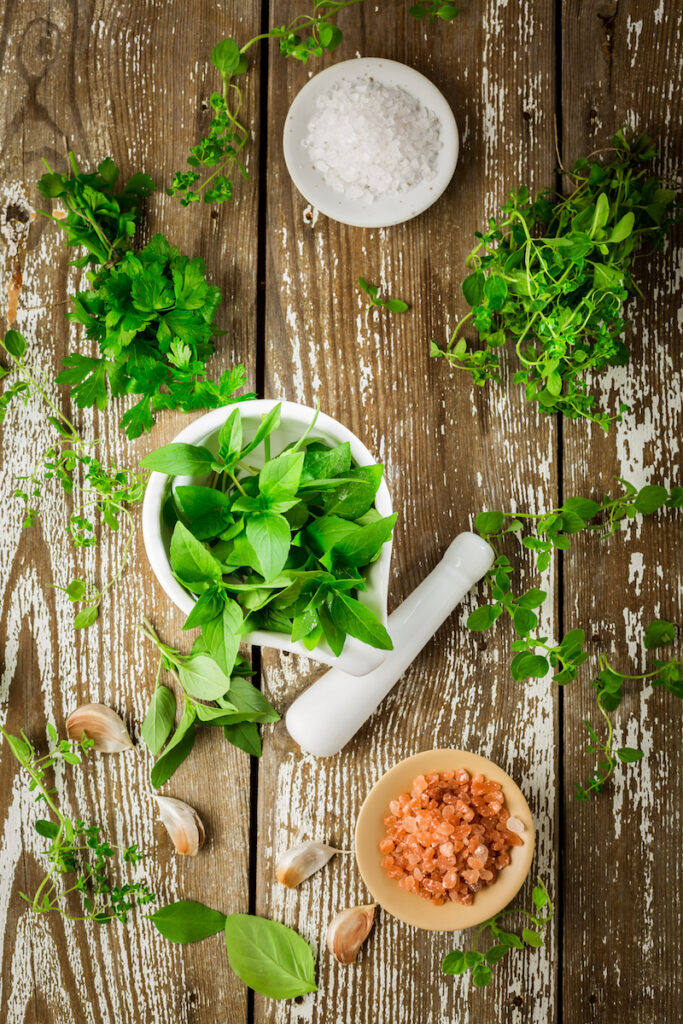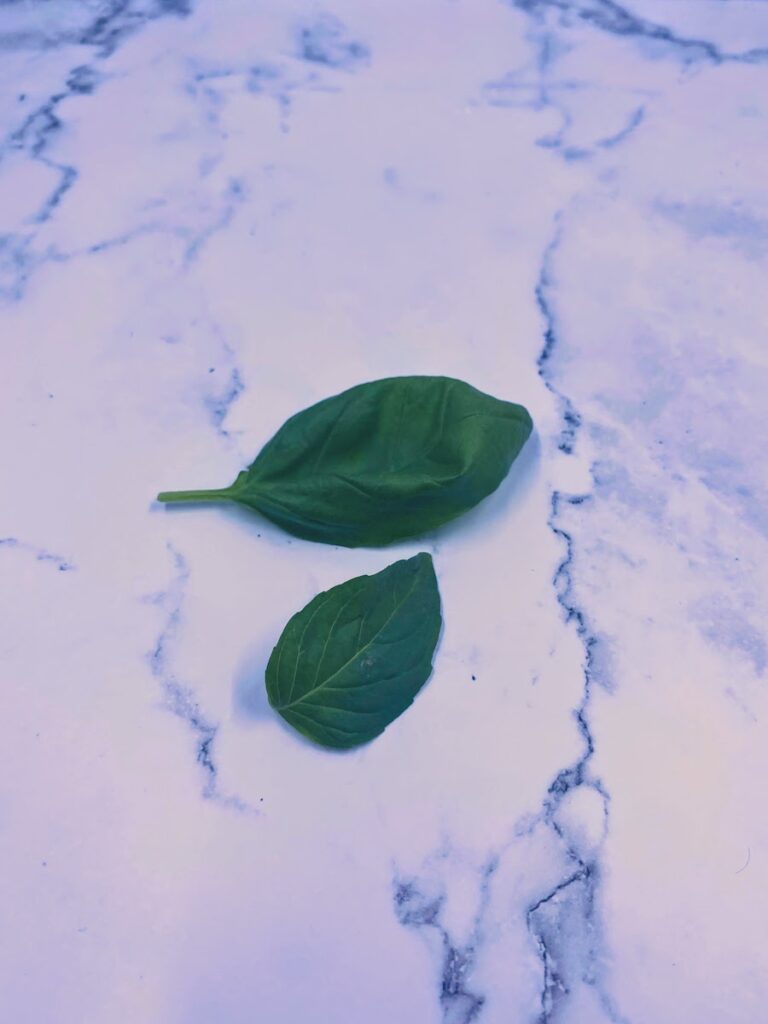As an Amazon Associate I earn from qualifying purchases. This website also participates in other affiliate programs and may earn commissions if you shop through the links used on this website.
(This article was originally published on July 15, 2022 and was last updated on September 10, 2022)
Used widely in Southeast Asian cuisine, Thai basil is better for extended cooking than common basil and has a slightly spicier and more complex flavor.
Aficionados of herbs in the basil genus may well find it an interesting herb to add to their home-growing repertoire – perhaps alongside holy basil, lemon basil and lime basil, which are also commonly used in the same region, or other types of basil such as dwarf Greek, Red Rubin, African Blue, or Lettuce Leaf or Purple varieties.

What is Thai Basil?
Thai basil has the Latin name Ocimum basilicum var. thyrsifolia. It is a variant of the species of sweet basil (Ocimum basilicum) which has been bred to provide distinctive characteristics.
Confusingly, it’s sometimes referred to as Cinnamon Basil, despite there also being a Ocimum basilicum Cinnamon, which is quite separate and different from Ocimum basilicum var. thyrsifolia!
Thai basil has smaller, narrower leaves than sweet basil.

It often has purple stems and pinkish-purple flowers.
Best of all? The leaves have a distinctive flavor with hints of anise and liquorice and a mild spice taste.

There are several different named cultivars and hybrids of Thai basil to consider growing in your garden.
This type of basil should not be confused with holy basil, or tulsi, which is sometimes referred to as Thai holy basil, Ocimum tenuiflorum.
Though related, holy basil has a much hotter, spicier, and more intense flavor profile than Thai basil.
How to Grow Thai Basil
Thai basil is a tender perennial herb though it is typically grown as an annual in temperate climes. It will only survive winter outdoors in frost-free, subtropical, or tropical areas.
That said, growing Thai basil is best done as an annual. Even though, with winter protection, it can last a few years, the flavor is best during the first growing season.
Where to Grow Thai Basil
If you do not live in an area with USDA hardiness zone 10 or above, you will have to grow Thai basil plants indoors or undercover if you want to try to grow it year-round. (Though, as mentioned above, this is not usually worthwhile.) Otherwise, it can grow outdoors, like other basils, as an annual over the summer months.
When choosing where to grow Thai basil, it is important to think carefully about the growing conditions it requires. It will do best in a location in full sun, which is relatively sheltered, and will not thrive where there are fewer than 6-8 hours of sunlight per day.
You can grow Thai basil in the ground, in raised beds, or containers. But when growing indoors, getting enough light can be a problem. You may need to consider an additional light source.
The soil or growing medium should be fertile and free-draining, with a pH of between 6.4 and 7.5 for best results.
Of course, you can grow Thai basil in a dedicated herb garden with other herbs that like similar growing conditions. You might also use Thai basil as a companion plant in your vegetable garden.
But I find that this basil is particularly useful in “edimental” planting schemes – in beds or borders which contain plants that are both edible and ornamental. The purplish stems and purple flowers (if you let these form) can be very attractive in your garden.
They look great, for example, alongside Mediterranean herbs like lavender, thyme, marjoram, and hyssop. Or native US plants like Agastache, echinacea, and bee balm, for example.
These plants are somewhat smaller than other basil varieties, which means that they can be useful in compact beds in smaller gardens too.
Sowing Thai Basil Seeds
To grow Thai basil from seed, start indoors around 3-4 weeks before the last expected frost date in your area. Or sow outside once the weather has warmed sufficiently. Plant seeds around a quarter of an inch deep.
You will likely need a propagator when sowing indoors and may like to use cloches or some other protection to improve success rates when direct sowing since germination will be unreliable if temperatures fall below around 70 degrees F.
One challenge in growing this type of basil in particular from seed is that germination rates can be patchy and low germination rates can occur if the conditions are not just right.
I once planted some seeds in a propagator, with good conditions, but only had one seedling emerge. I suspect that even with the heat of the propagator, temperatures were still a bit too low where I live. So if you are looking for an easier option – other basils are, in my experience, far easier to grow successfully from seed in a cooler temperate climate area.
If they germinate successfully, you should see seedlings emerge in around 10 days. Prick them out and pot them on when they have a few true leaves, then be sure to harden off plants grown indoors before you place them out into your garden.
Planting Thai Basil
Don’t plant out Thai basil until the weather and soil have warmed reliably where you live. The soil should be between 65 and 70 degrees F. A colder snap when temperatures fall below 50 F will set back the plant and can slow its growth for quite some time.
When planting out young plants, whether from containers they came in, or grown from seed or cuttings, make sure that you plant them at the same depth in the soil that they were at in their previous pot.
If you plan to continue to grow Thai basil in pots, be sure to choose a container that has adequate space and allows for adequate drainage, with a hole or holes at the base.
Caring for Thai Basil
Overwatering is by far a worse issue for Thai basil than watering too little, so err on the side of caution. Remember, these plants like free-draining conditions, and cannot tolerate waterlogging or damp conditions. Water plants in pots only well, but only water again when the top of the growing medium is dry.
Try to water early in the day. Make sure you direct water to the soil or growing medium and avoid wetting the leaves as much as possible.
Use an organic mulch around the plants to ensure ongoing fertility and improve the growing conditions.
Plants growing in the ground won’t need feeding. But plants in pots may benefit from the application of a nitrogen-rich, organic, liquid plant feed every couple of weeks through the main growing season.
Harvesting Thai Basil
Like other basils, Thai basil should be pruned regularly and harvested regularly throughout the growing season, as this will encourage bushier and healthier plants.
You can start harvesting a little from your plants as soon as they are around 10-15cm tall, and can continue to harvest as required through the summer months.
If you wish to continue to harvest for culinary use, get rid of any flowers that form. However, do consider leaving some plants to flower, as the flowers are attractive, and beneficial for pollinators in your garden.
How To Use Thai Basil
Thai basil can be used immediately or dried for later use. As mentioned above, it is frequently used in Southeast Asian cooking. Remember, this type of basil stands up better to heat or extended cooking than other basil types.
You can use it raw too – for salads, sandwiches, or as a garnish, where its unique flavor can add a lot of interest and a little can go a long way.
Thai basil is less suited to Italian inspired recipes, and you won’t catch most people throwing it on their pizza. However, there are some interesting ways to use it, such as with grilled summer squash.
Where to Buy Thai Basil
Here are some sources for Thai basil in the US if you’re unable to harvest your own Thai basil seeds:
- https://seedsofchange.com/seeds/herbs/organic-thai-basil-seeds
- https://www.backtonaturecompany.com/products/thai-basil-seeds-organic-non-gmo-heirloom-seeds-herb-seeds-usa-garden-seeds-fresh-2022
- https://strictlymedicinalseeds.com/product/basil-thai-ocimum-basilicum-seeds-organic/
- https://www.edenbrothers.com/store/organic-thai-basil-seeds.html
Final Thoughts on Growing Thai Basil
Thai basil is a must-grow for those who want to cook authentic southeast Asian cuisine, and could be an interesting plant for those looking for attractive additions to a herb or flower garden for an additional edible yield.
Elizabeth is a garden designer, consultancy and writer passionate about growing herbs and other edibles in a sustainable way. She works on her own 1/3 acre garden, growing basil alongside her tomatoes in her polytunnel, and indoors alongside a range of other herbs and crops. She loves inspiring others to get growing and enjoying a home grown diet, wherever they live in the world.

